What types of celery are there and how do they differ?
For a long time, celery in Russia was grown for decorative purposes. Only in the 17th century did people learn about the nutritional and beneficial properties of this crop, and began to plant food for consumption. Both the tops and roots of this vegetable are eaten.
In this article we will tell you in more detail about the varieties of celery, the peculiarities of its cultivation and beneficial properties.
Varieties of celery
Celery is divided into three groups depending on which part of the plant is eaten.
Sheet
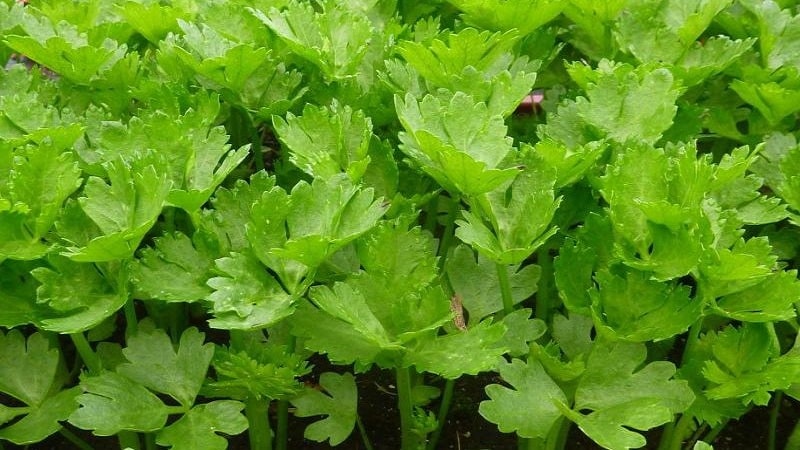
Leaf, or chives, are a lush, flavorful green that is eaten all summer. As soon as the leaves are cut off, new ones grow in their place. Leaf celery has a weak root system - its root is not suitable for food.
Chereshkovy

This type of celery has juicy petioles-stems of white or green color. The color depends on the amount of light that fell on the vegetable during growth. Petiolate species have a large, well-developed fleshy root and a weak leaf rosette.
The value of this variety of celery is in the basal thickened parts of the petioles, which ripen by the end of summer.
Root
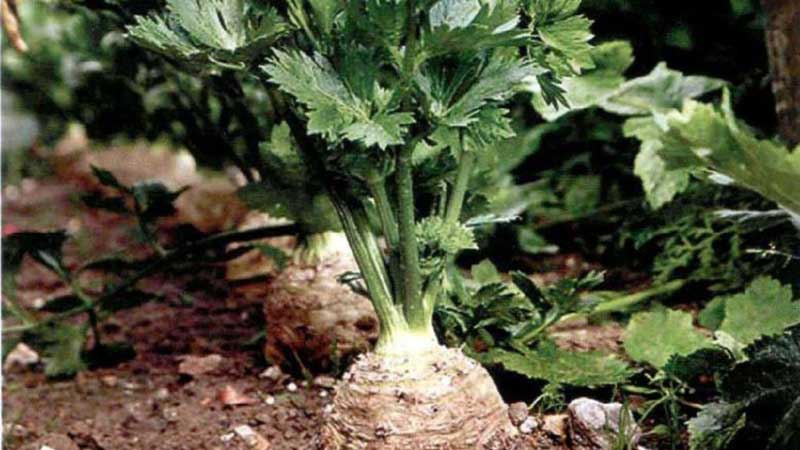
It is grown both for its foliage and for its round, fleshy, tasty root. The color of the root vegetable is brown or gray-white. The shape is knobby or flattened, 10-20 cm in diameter. The root has a specific aroma and the pulp has a bittersweet taste. The leaves of celery root are fluffy and soft.
What is the difference
Celery varieties differ in their edible parts.
Leaf celery is used to eat juicy greens.It looks like parsley, but is much softer and has a different aroma. In petiole celery, the root part of the petiole is eaten: it is thick, juicy and tasty.
Root celery is grown for its tasty root and lush greens. Since all the strength of root celery goes into the tops and roots, its petiole is thin and not suitable for food.
The best varieties of celery
Let's look at the characteristics of popular varieties of all types of celery.
Sheet
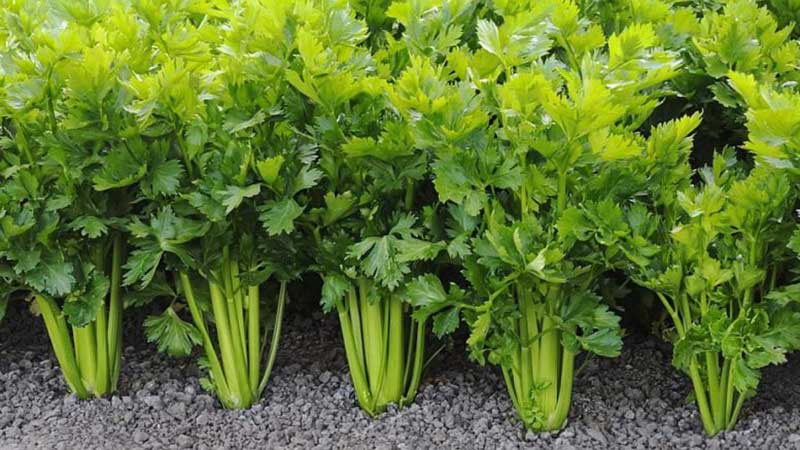
Leaf celery grows earlier than petiole and root celery - for this it is especially valued by gardeners.
Zakhar
A mid-late variety, subject to proper growing conditions, the greens grow up to 35 cm, the petiole is of medium length. The leaves are erect, up to 120 of them are formed on one plant, the rosette reaches 26 cm in diameter. The greens of this variety have a delicate taste, so they are eaten fresh.
Cheerfulness
The leaves are eaten after 70 days; they have a pleasant aroma and taste. The plant forms a powerful rosette with dense, erect leaves that are smooth and glossy. The greens of this variety are cut twice a season. The Vigor variety is resistant to lack of moisture and temperature changes. Greens are consumed fresh and canned.
Samurai
It takes 82 days from germination to harvest. Medium-sized green leaves with a corrugated edge are formed on hollow petioles. Samurai is unpretentious, so it is cultivated on all types of soil. The leaves have a pleasant aroma and a soft, delicate taste. They are used fresh and dried.
Sail
A variety with a relatively short ripening period: greens are eaten 90 days after germination. The rosette of this variety is semi-raised. The sail is valued for its ease of maintenance. The aromatic leaves are used in the preparation of salads, sauces, and soups.
Chereshkova

Petiole celery is divided into green varieties that require bleaching and self-bleaching varieties. The petioles of the second type of celery are bleached as they grow, covered with earth right up to the leaves. Losing their bright green color, they get rid of bitterness and overly spicy taste. Self-bleaching varieties do not require such a procedure.
The disadvantages of petiole species are low frost resistance and a short storage period. However, the petioles contain many useful substances; they are used as the main ingredient in dietary dishes when losing weight.
Male valor
Needs bleaching. Ready for harvest 150 days after emergence. The culture has light green, slightly curved, thick petioles with slight ribbing. The length of the green part is from 45 to 55 cm. The weight of the rosette reaches 600 g if all agrotechnical standards are observed.
Atlant
Needs bleaching. This variety is harvested on the 170th day. The petioles of the plant are 45 cm long, the weight of the rosette is approximately 400 g. If the conditions are met, 3 kg of crop is harvested from 1 m².
Pascal
Needs bleaching. The harvest is harvested after 100 days. The culture forms dark green, slightly curved petioles, reaching a length of 25-30 cm. The weight of the rosette is about 450 g. The petioles have a pleasant aroma and a juicy taste. The variety has increased cold resistance.
Gold
Self-bleaching. Duration of ripening – up to 160 days. Light green petioles of medium length, slightly ribbed, slightly curved. If the growing rules are followed, up to 5 kg of crop can be harvested from 1 m².
Tango
Self-bleaching. The life cycle of the plant reaches 180 days. The culture forms bluish-green petioles of a curved shape that do not contain coarse fiber. The weight of the socket reaches 800-900 g.Tango has an increased immunity to rust and color.
Malachite
Self-bleaching. It takes 90 days until the harvest is received. The plant forms light green, thick, fleshy, slightly curved, slightly ribbed petioles up to 35 cm long. Under cultivation conditions, the weight of the rosette reaches 1.2 kg.
Root

The low popularity of root celery is due to the fact that there are a limited number of varieties on sale and it is difficult to grow. Root celery is demanding to care for.
Russian size
Ripens in September, forms a heavy root crop weighing up to 3 kg with juicy pulp, a pleasant aroma and a slight nutty flavor. Easy to care for: loves well-lit places, prefers to grow on light, fertile soil.
Egor
Mid-season variety: 175 days pass from the appearance of sprouts to ripeness. The leaves are collected in a semi-raised rosette. The weight of the root crop is up to 450 g. The root crop is round in shape with a smooth surface, powerful, grayish-yellow. The pulp is white and aromatic. Egor has a high content of sugars, mineral salts and essential oils.
Diamond
The life cycle of the plant is 150 days. The culture forms a smooth, rounded root crop weighing 200 g. The peculiarity of the variety is that the pulp remains white even during long-term storage and heat treatment. The diamond rarely goes into the arrow.
Apple
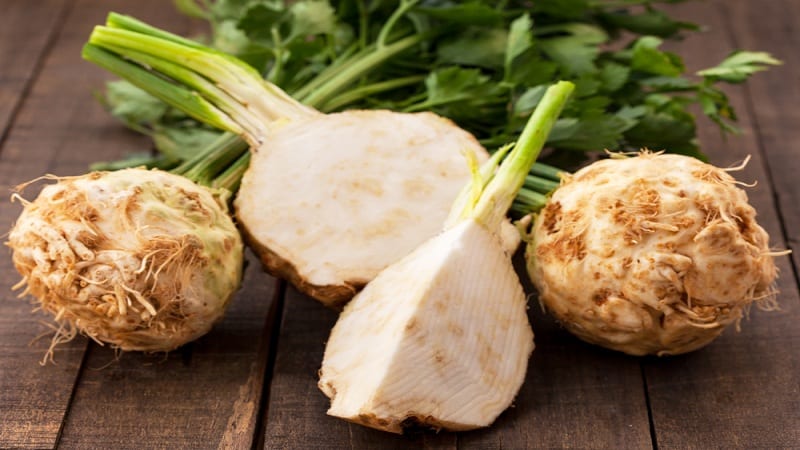
The leaves of the plant have a pleasant aroma. From the moment the seeds are planted until the harvest, up to 160 days pass. The round-shaped root vegetables weighing up to 140 g have snow-white flesh and a smooth surface. Up to 5 kg of crop is harvested from 1 m².
Apple considered the sweetest of the root varieties. It is resistant to diseases and pests.
Which varieties to choose for different growing regions
Our country has several climatic zones, so when choosing a variety for planting, the timing of its ripening is taken into account: early, mid-ripening, late.
In the central and southern regions it is customary to grow early and late varieties. The early ones will be used to sell greens at the market, the later ones will have time to ripen and will be well stored.
In the northern regions, only early and mid-season varieties are traditionally planted. Due to the onset of cold weather, the later ones do not ripen. Do not plant varieties that are too early - they are susceptible to frost. But if you plant them in a greenhouse and follow the cultivation conditions, the harvest is the same as in central Russia.
The following varieties are suitable for the Urals and Siberia: from root varieties - Russian Size and Egor, from leaf and petiole varieties - all listed above.
For central Russia, northeastern and central regions: from roots - Diamant and Yablochny, from leaf and petiolate - all the varieties listed above.
Features of cultivation depending on the type
Celery comes from the Mediterranean, where it is warm almost all year round. In Russia, weather conditions are radically different from the Mediterranean. Therefore, before growing the selected variety, they study the rules of its cultivation in the climatic conditions of the region of residence.
How to properly grow leaf celery
Leaf celery grown by seedlings or direct sowing in the garden. You can buy ready-made seedlings, but there is a risk that parsley will be hidden under the guise of celery or the seedlings may be infected with diseases.
Seeds are planted for seedlings at the end of March. For 2-3 days before sowing, they are soaked in water to swell. Sow seeds in boxes, the distance between rows is 6-7 cm. If there are no boxes, peat tablets will do.Place the container with seeds in a room with a constant air temperature of +20...+25°C in a sunny place. Water after 2 days.
Shoots appear on days 15-20, after which the room temperature is reduced to +14...+15°C. When 2-3 true leaves appear, the seedlings are transplanted into separate pots: 1 sprout - 1 pot. The seedlings are transferred to the ground in early May.
Reference. The seedling method is more effective, but due to the small size of the seeds, it is inconvenient to work with them. Their germination rate is low.
In May, seeds are sown using direct sowing. They are planted densely and shallowly: 1-2 cm. Celery seeds are small and difficult to germinate: sprouts appear on the 20-25th day.
Caring for leaf celery in open ground means watering 2-3 times a week with about 5 liters per 1 m². The soil in the garden bed should be constantly moist. An effective way to achieve these conditions is to mulch and water as the mulch dries. The day after watering, the unmulched beds are loosened to provide the root system with oxygen.
If the shoots are dense, the plant is thinned out: weak and painful shoots are removed. They are fed with complex potassium-nitrogen fertilizers 2 weeks after planting in the beds. Be sure to weed as weeds appear to prevent the plant from getting sick.
Attention! To ensure that fragrant celery greens are on the table all summer long, several varieties with different ripening periods are planted.
Planting and caring for petiole varieties
The agricultural technology for growing petiole celery is complex - it is sensitive to cold and temperature changes. During the growth process, the petioles of some varieties will have to be bleached - this also takes time.
Seeds for seedlings Planted in March in plastic or wooden containers. They fall asleep in them ordinary soil with a predominance of the peat component and slightly moisturize. The seeds are laid out on the surface, pressed down with a planting board and sprinkled to a depth of 3 mm. Again, lightly press down and spray with warm water from a spray bottle.
Cover with film or glass to create a greenhouse effect. Place in a room with a temperature of +20…+22°C. Every day the shelter is removed for ventilation. Spray as the soil dries.
Petiole celery seeds germinate in 20 days. After this, the temperature is lowered to +15...+17°C, the film (glass) is removed and exposed to light. Water if necessary. Feed with nitrophoska solution 2 times every 10 days.
Important! The best place for celery is an open, sunny, warm area without wind or draft.
Self-bleaching varieties are sown in the garden. Non-self-bleaching - in a trench, this will make it easier to bleach the petiole to remove bitterness and give it crunch and a pleasant taste. Bleach the petiole, sprinkling it with soil as it grows. If it is not possible to sprinkle it, cover it with cardboard/thick paper/wallpaper. And so on until the harvest.
The soil should be loose: for this purpose, manure is added to it in the fall, and compost or humus is added to it in the spring. Otherwise, the care is the same as for leaf celery: weeding, loosening, watering. To prevent the petiole from rotting and to be tasty, do not allow water to stagnate in the garden bed.
Agricultural technology of root celery
This type is only gaining popularity. It is more difficult to cultivate than petiole varieties.
In root varieties the growing season is long - up to 200 days, therefore, for regions with a changeable climate, early varieties are chosen and cultivated through seedlings. In the southern regions, root celery is planted in open ground.
Sow the crop for seedlings at the end of February - beginning of March in light nutrient soil in any container. Seeds are germinated by soaking them in water for 2-3 days. Sprouted seeds are planted in shallow holes, 1-2 pieces each. and sprinkle. The boxes are covered with film. After germination, it is removed and the seedlings are lightly sprinkled with earth. If the seedlings are dense, weak shoots are removed.
After 3-4 leaves appear, the seedlings are planted in separate cups. Do this carefully: if the root is damaged, this will lead to deformation of the root crop or death of the plant.
Sow seedlings in open ground in well-warmed soil in late May - early June. The distance between seedlings is 20 cm, between rows is 30 cm.
Attention! If the plant is exposed to spring cold, it throws out flower stalks: in this case, the root crop is not formed.
The land for celery is prepared in the fall: humus is added.
When the plant takes root well, new leaves appear on it. Immediately after this, the soil around the plant is raked and excess lateral roots are cut off with a knife. If this is not done, the root crops will be deformed and will not have a rounded presentation. To prevent the root crop from flattening, the lower leaves of the plant are removed as they appear.
Watering, loosening and weeding are done in the same way as for leaf celery. But hilling is not recommended for better root formation.
2 weeks after the seedlings take root in the garden bed, they are fed with mullein or chicken droppings. At the end of July - with superphosphate, and when the head begins to set - with a solution of boric acid.
How different types of celery are used
Celery contains essential oil, vitamins A, E, C, K, B, oxalic acid, mineral salts of potassium, calcium, phosphorus, sodium.This valuable composition slows down the aging process, has a calming effect, activates the secretion of gastric juice, and rids the intestines of toxins.
In cooking

Without celery, dietary and healthy eating is impossible. Eaten all parts of the plant:
- the root is boiled and baked;
- the stems are fried, stewed or eaten raw;
- the leaves are dried, added fresh to salads, and used to decorate dishes;
- seeds are included in seasonings.
The plant has a spicy, bittersweet taste and bright aroma. It is added to meat, vegetable, mushroom, and fish dishes.
Tender, juicy stems and leaves, as well as finely chopped roots, are used as an additive to soups and salads. Powdered dried celery is added to sauces, broths, egg dishes, goose, duck and chicken.
Celery goes best with vegetables: cabbage, beans, eggplant, carrots, potatoes and tomatoes. Celery gives them a spicy taste and rich aroma.
In folk medicine
When consumed daily, celery has a cleansing, tonic and rejuvenating effect on the body.
The vegetable helps the functioning of the kidneys, bladder and colon. Greens and root vegetables are included in therapeutic dietary nutrition for gastritis, gastric ulcers and chronic colitis. Celery increases diuresis, so waste is removed from the body faster. It is also indicated for fatigue and overexcitement.
When to use the infusion:
- from celery leaves - to remove toxins and waste;
- from the roots - for constipation, vomiting, gastritis, stomach and duodenal ulcers.
When drinking the decoction:
- from the roots - for mental fatigue, in the complex treatment of diseases of the genital organs;
- from greens – for kidney inflammation and prostatitis;
- from dried herbs or seeds - for the treatment and prevention of urolithiasis;
- from seeds - for painful menstruation.
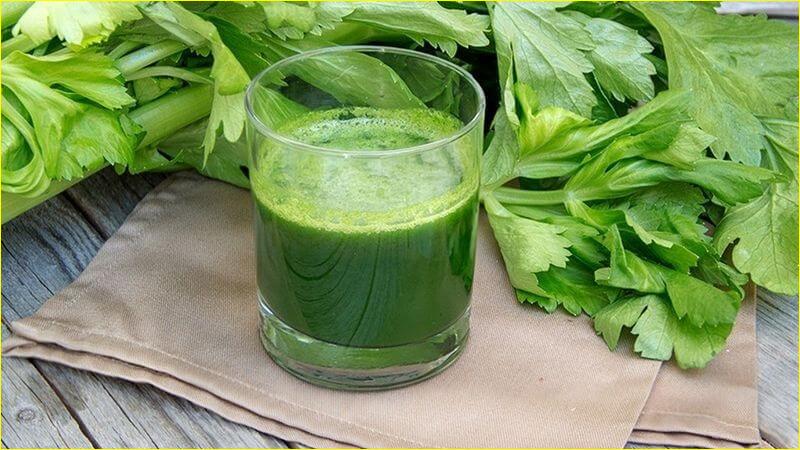
To prepare an infusion or decoction, take 1 part of the plant and 10 parts of water at room temperature, mix and heat in a boiling water bath: infusion - 15 minutes, decoction - 30 minutes. The infusion is left at room temperature for 45 minutes, the decoction for 10 minutes. The prepared medicine is filtered and the residue is squeezed out.
Juice from celery petioles is used to treat affected areas of the skin for allergic dermatitis and urticaria.
Reference. Celery is considered an essential component of a man's diet. This is a natural aphrodisiac that enhances potency.
For weight loss
Regular consumption of celery promotes weight loss, as this vegetable normalizes metabolism and contains only 18 kcal per 100 g of product. Celery is a “negative calorie” vegetable because it uses more calories to digest than it takes in. In addition, it has a diuretic effect and eliminates excess fluid in the body. The basis of the celery diet is soup. Supplement the diet with vegetables and fruits (except grapes and bananas), rice, lean meat and kefir.
Ingredients for celery soup: 400 g stalks, 6 onions, 3 fresh tomatoes, 500 g white cabbage, 2 green bell peppers, salt and ground black pepper. Vegetables are washed, peeled, finely chopped, pour in 3 liters of water, salt and pepper, boil for 10 minutes, reduce heat and cook until the vegetables are soft.
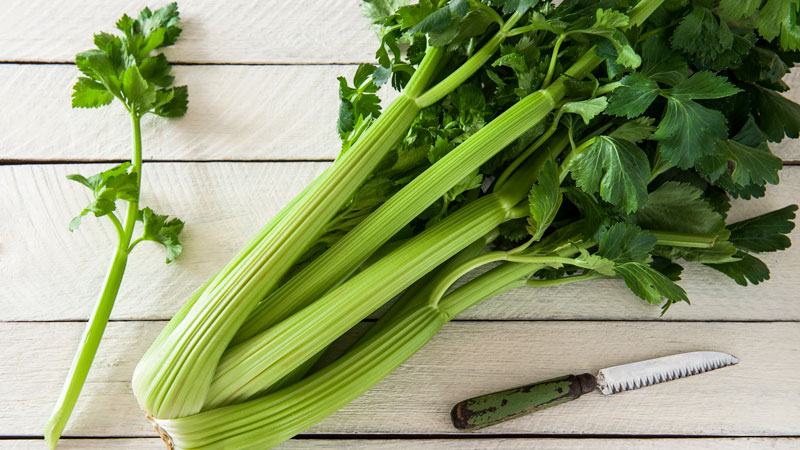
Rules for the celery diet:
- complete refusal of sweet, flour, salty, smoked and pickled foods;
- tea and coffee - without sugar;
- celery soup - in unlimited quantities.
As a result of the diet, they lose from 2 to 4 kg.
Attention! The diet is not suitable for people suffering from thrombophlebitis, varicose veins, ulcers, pancreatitis, hypertension, epilepsy, kidney stones, and nursing women.
Conclusion
To get a rich harvest of celery on your site, wisely choose the variety and variety of the crop, taking into account climatic conditions and growing purposes. Celery is a capricious plant; it requires careful care during the seedling period and while growing in the garden.